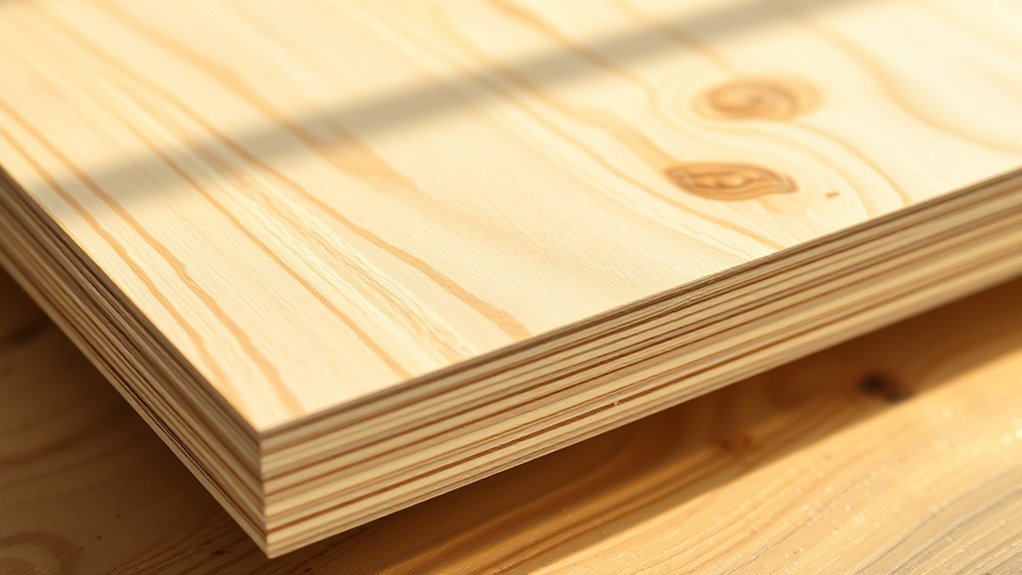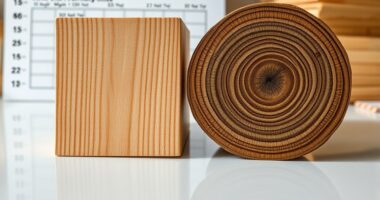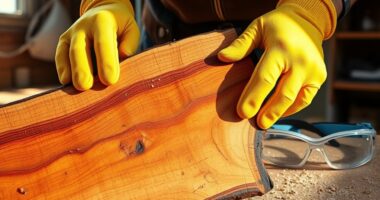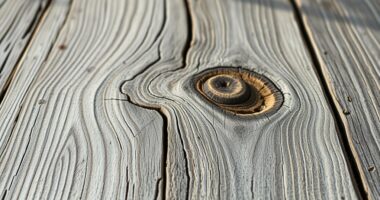To identify plywood grades quickly and avoid hidden voids, look for uniform grain patterns and smooth surfaces, which indicate higher-quality panels. A-grade plywood typically has minimal knots and defects, showing a consistent appearance, while lower grades may have more imperfections and varied grains. Rotary cut veneers usually result in better quality and fewer hidden voids. Checking for irregularities can save you from surprises, and if you continue exploring, you’ll discover even more tips for selecting the best plywood.
Key Takeaways
- Higher-grade plywood (A or B) features smooth, uniform grain patterns with minimal knots or patches, indicating fewer hidden voids.
- Consistent and regular grain patterns suggest better manufacturing quality and reduced likelihood of concealed defects.
- Examine plywood for irregularities or inconsistencies in the grain pattern, which may signal underlying voids or flaws.
- Use light or gentle tapping to detect hidden voids beneath the veneer, especially in lower-grade or uneven surfaces.
- Opt for rotary-cut veneers and higher-grade classifications to ensure structural integrity and minimize the risk of hidden voids.

Ever wondered how to choose the right plywood for your project? It all begins with understanding the different grades and how they relate to what you’ll be working on. One key aspect to consider is the grain patterns, which can tell you a lot about the plywood’s appearance and structural quality. Grain patterns are influenced by the manufacturing processes, which determine how the veneers are layered and bonded. When you select plywood, paying attention to these patterns helps you identify the grade and avoid surprises like hidden voids that can compromise your project’s durability. Recognizing the importance of grain pattern consistency can guide you in selecting higher-quality plywood that minimizes the risk of defects. Plywood grades are primarily classified based on the appearance of the face and back veneers. The highest quality, like A-grade, features a smooth surface with minimal knots, splits, or patches, making it ideal for visible applications. Lower grades, such as C or D, may have more noticeable imperfections, but they’re still structurally sound for non-visible uses. To accurately assess these grades, you need to examine the grain patterns closely. Uniform grain patterns often indicate high-quality manufacturing processes that use careful veneer selection and bonding techniques, resulting in fewer defects.
Manufacturing processes play a pivotal role in determining the overall quality of plywood. For instance, rotary cut veneers tend to produce more consistent grain patterns with fewer voids, which is desirable if you want a cleaner appearance. Conversely, plain or half-round cuts might result in more noticeable grain variations, affecting the grade. Understanding how manufacturing processes influence grain patterns helps you predict where hidden voids or weak spots might be lurking. These voids often form during the pressing and bonding stages when veneers aren’t properly aligned or when defective veneers slip through quality control.
To avoid hidden voids, it’s essential to inspect plywood sheets thoroughly. Look for irregularities in the grain pattern, which could signal underlying gaps or weak spots. Often, voids are concealed beneath the surface veneer, so shining a light behind the panel or tapping it gently can reveal hollow areas. Recognizing signs of manufacturing flaws, such as inconsistent grain or uneven surfaces, helps you select plywood that’s less likely to contain hidden defects. Remember, higher-grade plywood with uniform grain patterns not only looks better but also tends to be more reliable structurally.
Frequently Asked Questions
How Do Plywood Grades Affect Overall Durability?
Your plywood’s grade impacts its overall durability because higher grades typically feature better grain patterns and fewer defects, making them stronger and more resistant. The adhesive quality also plays a vital role—better adhesives ensure the layers stay bonded under stress. When you choose a grade with consistent grain patterns and high-quality adhesive, you enhance the plywood’s strength and longevity, guaranteeing it withstands wear and environmental factors over time.
Can Grade Differences Impact Plywood’S Water Resistance?
Grade differences can considerably impact plywood’s water resistance. Higher-grade plywood, like A or B, usually has fewer defects and a tighter surface, which helps repel water better. Lower grades, such as C or D, often have more voids and surface imperfections, making them less water-resistant. So, if you need plywood for outdoor or moisture-prone areas, choosing a higher grade guarantees better durability and protection against water damage.
Are There Eco-Friendly Plywood Grade Options?
You’re interested in eco-friendly plywood options. Thankfully, sustainable options exist that prioritize environmental responsibility. Look for plywood with eco-friendly certifications like FSC or PEFC, which guarantee the wood is responsibly sourced. These grades often use fewer harmful chemicals and sustainable practices, making them a better choice for eco-conscious projects. By choosing certified plywood, you support sustainable forestry and reduce your environmental impact.
How Do I Identify Hidden Voids in Plywood?
Ever wonder if hidden voids are lurking in your plywood? To detect them, look closely at the grain pattern—irregularities or gaps can signal trouble. Run your fingers over the surface finish; a smooth feel may hide imperfections. Hold the plywood up to a light source to reveal dark spots or inconsistencies. These simple checks help you avoid surprises, ensuring your project’s strength and durability.
What Tools Are Best for Inspecting Plywood Quality?
To inspect plywood quality, you should use a flashlight or magnifying glass to examine the grain pattern and surface finish closely. These tools help you spot irregularities or inconsistencies that might indicate hidden voids or defects. A keen eye combined with good lighting allows you to detect areas where the grain isn’t uniform or the surface isn’t smooth, ensuring you select strong, high-quality plywood free of hidden issues.
Conclusion
Now that you know how to identify plywood grades at a glance, you’ll avoid hidden voids and guarantee your project’s strength. Remember, don’t be fooled by appearances—just like a knight inspecting armor before battle, take the time to check each sheet carefully. With this knowledge, you’ll craft with confidence, avoiding surprises that could turn your masterpiece into a Shakespearean tragedy. Stay vigilant, and your work will stand the test of time, just like a sturdy castle in a fairy tale.









